BSBFIN501: Detailed Assessment on Managing Budgets and Financial Plans
VerifiedAdded on 2023/06/09
|17
|4083
|377
Homework Assignment
AI Summary
This document presents a comprehensive solution to the BSBFIN501 Manage Budgets and Financial Plans assignment. It begins with an introduction outlining the assessment tasks, including knowledge questions and a project portfolio, designed to evaluate the student's understanding of financial management principles. The assignment delves into core accounting concepts such as double-entry bookkeeping, cash and accrual accounting, and depreciation. It explores different types of budgets, the Goods and Services Tax (GST) Act, taxation and superannuation obligations for businesses, and record-keeping requirements for tax purposes. Furthermore, the document addresses key principles for managing a work team, the differences between static and flexible budgets, and the relevance of electronic spreadsheets in budgeting. It also covers GST reporting frequency, detailed descriptions of financial statements (cash flow statements, balance sheets, profit and loss statements, and ledgers), and methods for evaluating a budget or financial plan. The assignment provides a thorough understanding of the practical aspects of managing budgets and financial plans within an organizational context.

BSBFIN501 Manage Budgets
and Financial Plans
Assessment Tasks
and Financial Plans
Assessment Tasks
Paraphrase This Document
Need a fresh take? Get an instant paraphrase of this document with our AI Paraphraser
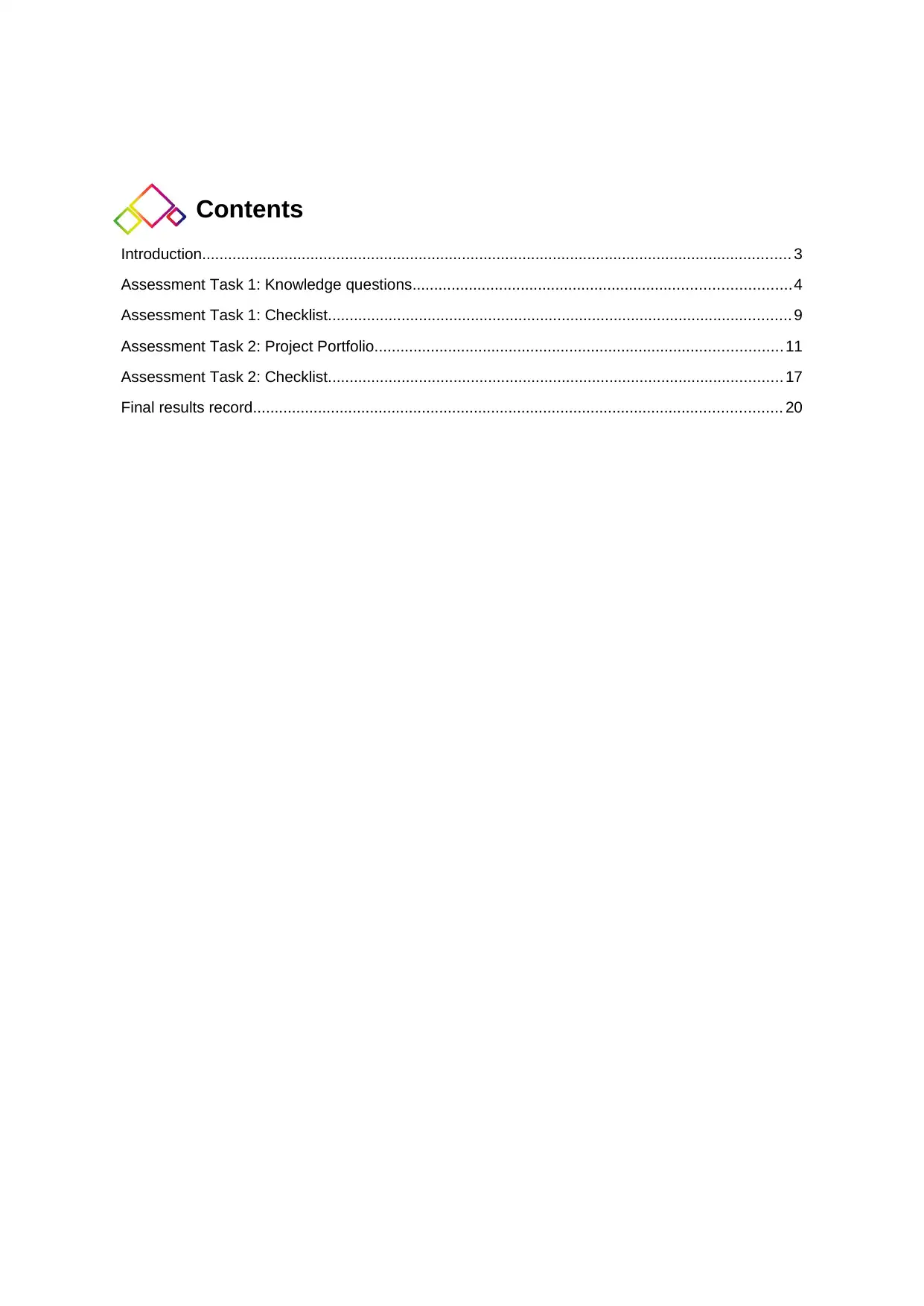
Contents
Introduction........................................................................................................................................ 3
Assessment Task 1: Knowledge questions.......................................................................................4
Assessment Task 1: Checklist........................................................................................................... 9
Assessment Task 2: Project Portfolio.............................................................................................. 11
Assessment Task 2: Checklist......................................................................................................... 17
Final results record.......................................................................................................................... 20
Introduction........................................................................................................................................ 3
Assessment Task 1: Knowledge questions.......................................................................................4
Assessment Task 1: Checklist........................................................................................................... 9
Assessment Task 2: Project Portfolio.............................................................................................. 11
Assessment Task 2: Checklist......................................................................................................... 17
Final results record.......................................................................................................................... 20
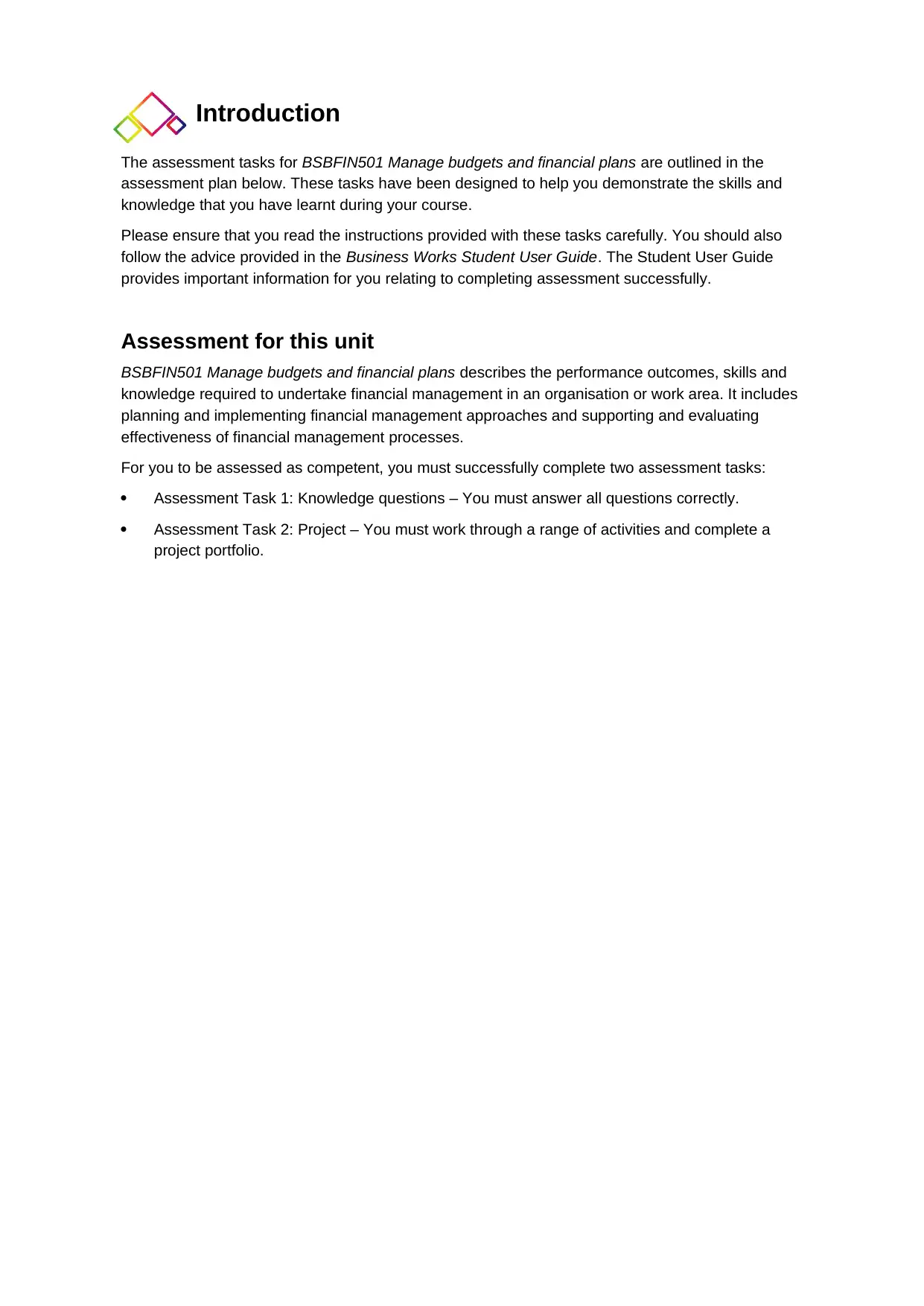
Introduction
The assessment tasks for BSBFIN501 Manage budgets and financial plans are outlined in the
assessment plan below. These tasks have been designed to help you demonstrate the skills and
knowledge that you have learnt during your course.
Please ensure that you read the instructions provided with these tasks carefully. You should also
follow the advice provided in the Business Works Student User Guide. The Student User Guide
provides important information for you relating to completing assessment successfully.
Assessment for this unit
BSBFIN501 Manage budgets and financial plans describes the performance outcomes, skills and
knowledge required to undertake financial management in an organisation or work area. It includes
planning and implementing financial management approaches and supporting and evaluating
effectiveness of financial management processes.
For you to be assessed as competent, you must successfully complete two assessment tasks:
Assessment Task 1: Knowledge questions – You must answer all questions correctly.
Assessment Task 2: Project – You must work through a range of activities and complete a
project portfolio.
The assessment tasks for BSBFIN501 Manage budgets and financial plans are outlined in the
assessment plan below. These tasks have been designed to help you demonstrate the skills and
knowledge that you have learnt during your course.
Please ensure that you read the instructions provided with these tasks carefully. You should also
follow the advice provided in the Business Works Student User Guide. The Student User Guide
provides important information for you relating to completing assessment successfully.
Assessment for this unit
BSBFIN501 Manage budgets and financial plans describes the performance outcomes, skills and
knowledge required to undertake financial management in an organisation or work area. It includes
planning and implementing financial management approaches and supporting and evaluating
effectiveness of financial management processes.
For you to be assessed as competent, you must successfully complete two assessment tasks:
Assessment Task 1: Knowledge questions – You must answer all questions correctly.
Assessment Task 2: Project – You must work through a range of activities and complete a
project portfolio.
⊘ This is a preview!⊘
Do you want full access?
Subscribe today to unlock all pages.

Trusted by 1+ million students worldwide
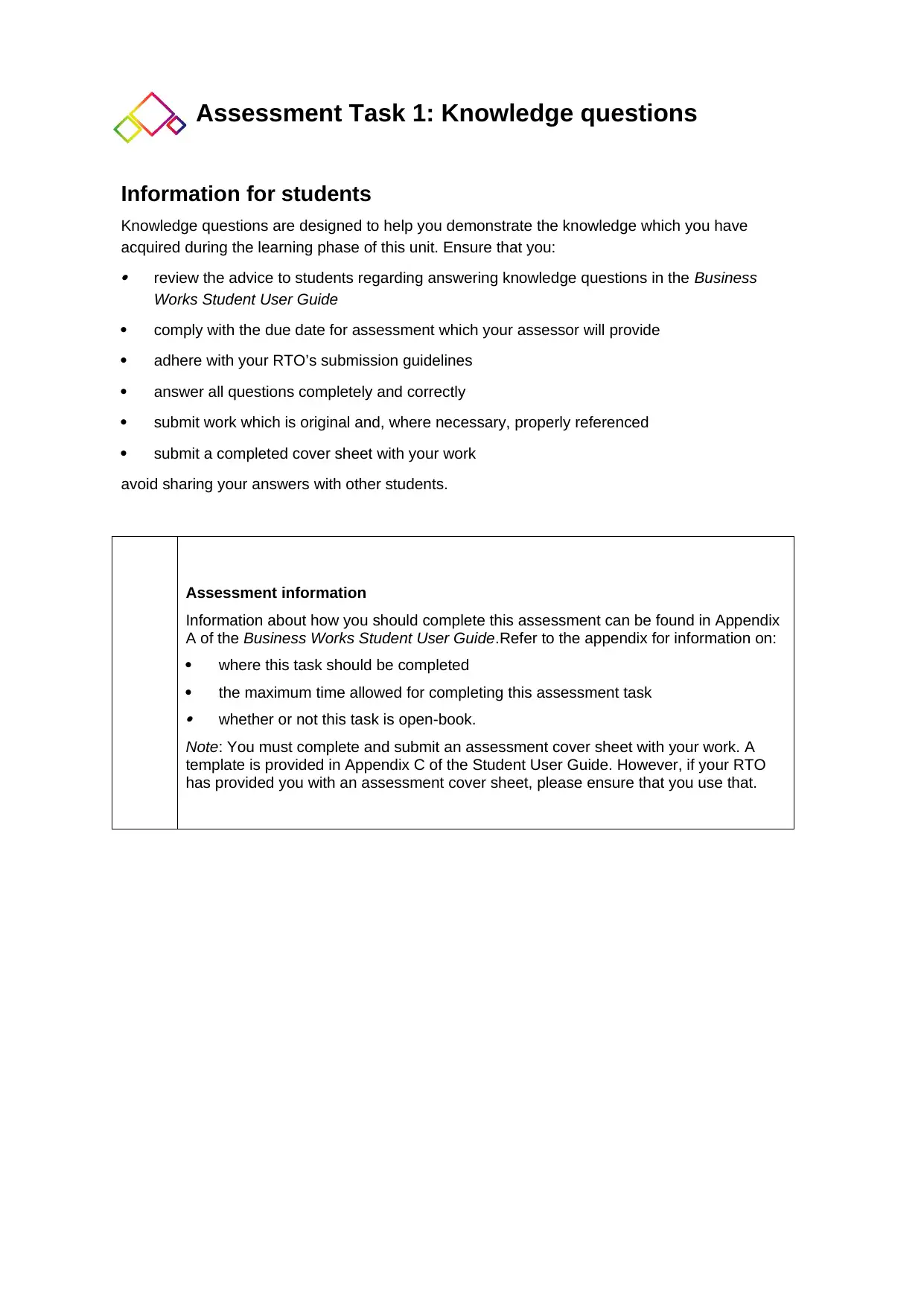
Assessment Task 1: Knowledge questions
Information for students
Knowledge questions are designed to help you demonstrate the knowledge which you have
acquired during the learning phase of this unit. Ensure that you: review the advice to students regarding answering knowledge questions in the Business
Works Student User Guide
comply with the due date for assessment which your assessor will provide
adhere with your RTO’s submission guidelines
answer all questions completely and correctly
submit work which is original and, where necessary, properly referenced
submit a completed cover sheet with your work
avoid sharing your answers with other students.
Assessment information
Information about how you should complete this assessment can be found in Appendix
A of the Business Works Student User Guide.Refer to the appendix for information on:
where this task should be completed
the maximum time allowed for completing this assessment task
whether or not this task is open-book.
Note: You must complete and submit an assessment cover sheet with your work. A
template is provided in Appendix C of the Student User Guide. However, if your RTO
has provided you with an assessment cover sheet, please ensure that you use that.
Information for students
Knowledge questions are designed to help you demonstrate the knowledge which you have
acquired during the learning phase of this unit. Ensure that you: review the advice to students regarding answering knowledge questions in the Business
Works Student User Guide
comply with the due date for assessment which your assessor will provide
adhere with your RTO’s submission guidelines
answer all questions completely and correctly
submit work which is original and, where necessary, properly referenced
submit a completed cover sheet with your work
avoid sharing your answers with other students.
Assessment information
Information about how you should complete this assessment can be found in Appendix
A of the Business Works Student User Guide.Refer to the appendix for information on:
where this task should be completed
the maximum time allowed for completing this assessment task
whether or not this task is open-book.
Note: You must complete and submit an assessment cover sheet with your work. A
template is provided in Appendix C of the Student User Guide. However, if your RTO
has provided you with an assessment cover sheet, please ensure that you use that.
Paraphrase This Document
Need a fresh take? Get an instant paraphrase of this document with our AI Paraphraser

Questions
Provide answers to all of the questions below:
Explain the basic principle of double entry bookkeeping.
The basic principles of accounting states that every for every entry which is debit in the books of
accounts must have the corresponding entry in books of accounts. This is called as foundation of
book keeping. Book-keeping is an activity concerned with the recording of financial data relating to
business operations in a significant and orderly manner. It covers procedural aspects of accounting
work and embraces record keeping function. Obviously, book-keeping procedures are governed by
the end product, the financial statements. The term ‘financial statements’ means Profit and Loss
Account, Balance Sheet and cash flow statements including Schedules and Notes forming part of
Accounts. Book-keeping also requires suitable classification of transactions and events. This is
also determined with reference to the requirement of financial statements. A book-keeper may be
responsible for keeping all the records of a business or only of a minor segment, such as position
of the customers’ accounts in a departmental store. Accounting is based on a careful and efficient
book-keeping system.
Complete the following table to describe the principles of cash and accrual accounting and an
advantage and disadvantage of each method of accounting.
Type of accounting
method
Description One advantage and one
disadvantage of this method
Cash accounting In cash system of accounting
the transactions are being
recording in the books when
there is actual flow of cash in
the business in the form of
outflow or inflow.
The main advantage of this
accounting system is that it is very
easy to understand as compare to
other accounting system as only
those transactions are to be
accounted for which are received or
paid in cash. The disadvantage of
this accounting system is that this
method only considers single entry
system of accounting as chances of
error are higher in numbers.
Accrual accounting In this system of accounting
the transactions are being
recorded in the books when
the income or expense is
earned or incurred
irrespective of the fact that
whether they are actually
collected or paid.
The main advantage of this system
of accounting is that it provides the
complete picture of overall cash
flows that is generated in the
business throughout the year. And
the disadvantage of this system of
accounting it that implementation of
this method in a small business
having limited number of staff may
be difficult to implement.
Explain the two accounting principles on which the calculation and reporting of depreciation is
based.
Cost Principle: The calculation and reporting of depreciation is based upon Cost principle. This
principle requires that the depreciation expense reported on the income statement and the asset
amount that is reported on the balance sheet should be based on the historical cost of the asset.
Matching Principle: It is one of the basic underlying principles in accounting. It directs a company to
report an expense in the same period as the related revenues on its income statement. It requires
that asset cost be allocated to depreciation expense over the life of the asset. The cost of asset is
Provide answers to all of the questions below:
Explain the basic principle of double entry bookkeeping.
The basic principles of accounting states that every for every entry which is debit in the books of
accounts must have the corresponding entry in books of accounts. This is called as foundation of
book keeping. Book-keeping is an activity concerned with the recording of financial data relating to
business operations in a significant and orderly manner. It covers procedural aspects of accounting
work and embraces record keeping function. Obviously, book-keeping procedures are governed by
the end product, the financial statements. The term ‘financial statements’ means Profit and Loss
Account, Balance Sheet and cash flow statements including Schedules and Notes forming part of
Accounts. Book-keeping also requires suitable classification of transactions and events. This is
also determined with reference to the requirement of financial statements. A book-keeper may be
responsible for keeping all the records of a business or only of a minor segment, such as position
of the customers’ accounts in a departmental store. Accounting is based on a careful and efficient
book-keeping system.
Complete the following table to describe the principles of cash and accrual accounting and an
advantage and disadvantage of each method of accounting.
Type of accounting
method
Description One advantage and one
disadvantage of this method
Cash accounting In cash system of accounting
the transactions are being
recording in the books when
there is actual flow of cash in
the business in the form of
outflow or inflow.
The main advantage of this
accounting system is that it is very
easy to understand as compare to
other accounting system as only
those transactions are to be
accounted for which are received or
paid in cash. The disadvantage of
this accounting system is that this
method only considers single entry
system of accounting as chances of
error are higher in numbers.
Accrual accounting In this system of accounting
the transactions are being
recorded in the books when
the income or expense is
earned or incurred
irrespective of the fact that
whether they are actually
collected or paid.
The main advantage of this system
of accounting is that it provides the
complete picture of overall cash
flows that is generated in the
business throughout the year. And
the disadvantage of this system of
accounting it that implementation of
this method in a small business
having limited number of staff may
be difficult to implement.
Explain the two accounting principles on which the calculation and reporting of depreciation is
based.
Cost Principle: The calculation and reporting of depreciation is based upon Cost principle. This
principle requires that the depreciation expense reported on the income statement and the asset
amount that is reported on the balance sheet should be based on the historical cost of the asset.
Matching Principle: It is one of the basic underlying principles in accounting. It directs a company to
report an expense in the same period as the related revenues on its income statement. It requires
that asset cost be allocated to depreciation expense over the life of the asset. The cost of asset is
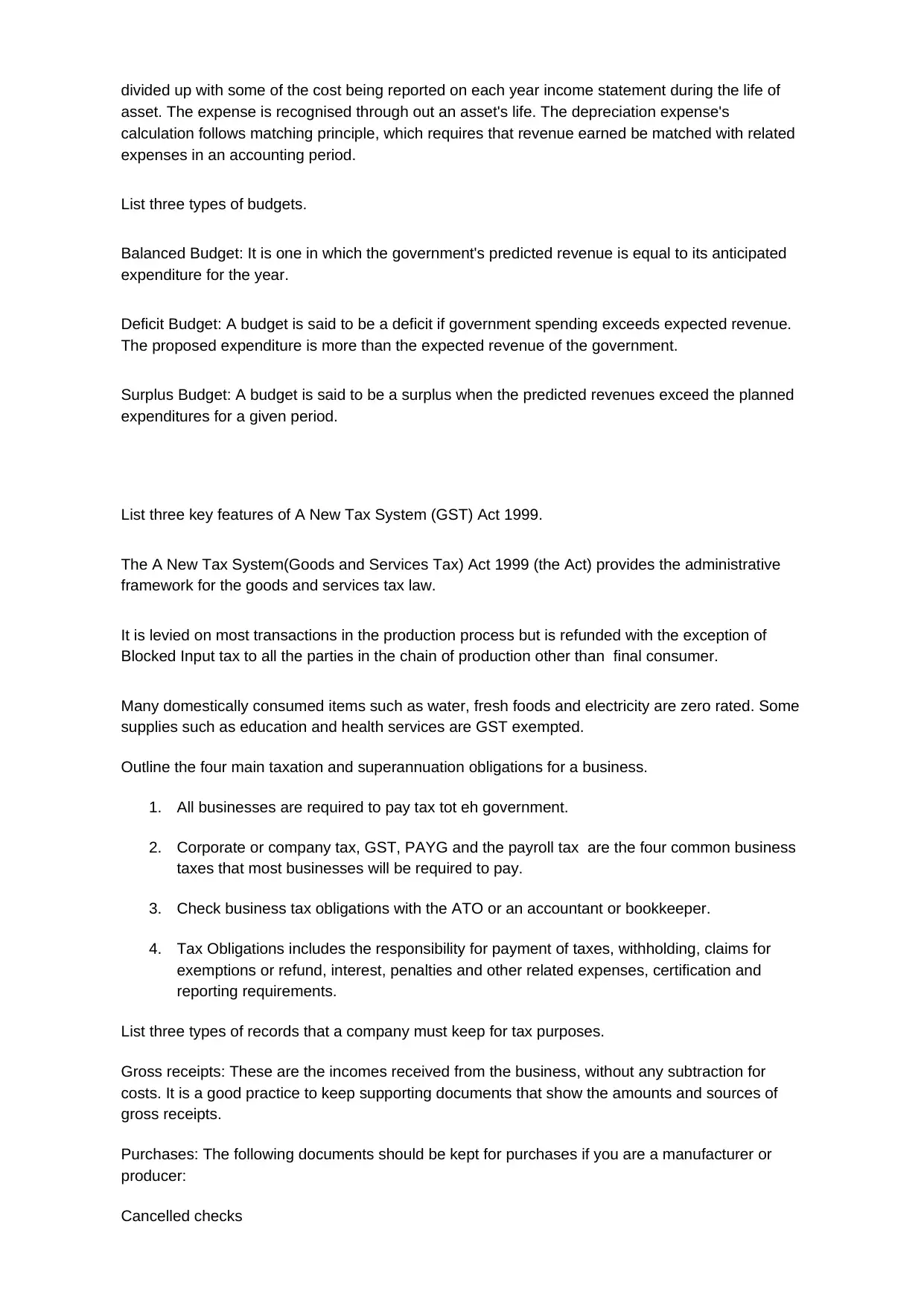
divided up with some of the cost being reported on each year income statement during the life of
asset. The expense is recognised through out an asset's life. The depreciation expense's
calculation follows matching principle, which requires that revenue earned be matched with related
expenses in an accounting period.
List three types of budgets.
Balanced Budget: It is one in which the government's predicted revenue is equal to its anticipated
expenditure for the year.
Deficit Budget: A budget is said to be a deficit if government spending exceeds expected revenue.
The proposed expenditure is more than the expected revenue of the government.
Surplus Budget: A budget is said to be a surplus when the predicted revenues exceed the planned
expenditures for a given period.
List three key features of A New Tax System (GST) Act 1999.
The A New Tax System(Goods and Services Tax) Act 1999 (the Act) provides the administrative
framework for the goods and services tax law.
It is levied on most transactions in the production process but is refunded with the exception of
Blocked Input tax to all the parties in the chain of production other than final consumer.
Many domestically consumed items such as water, fresh foods and electricity are zero rated. Some
supplies such as education and health services are GST exempted.
Outline the four main taxation and superannuation obligations for a business.
1. All businesses are required to pay tax tot eh government.
2. Corporate or company tax, GST, PAYG and the payroll tax are the four common business
taxes that most businesses will be required to pay.
3. Check business tax obligations with the ATO or an accountant or bookkeeper.
4. Tax Obligations includes the responsibility for payment of taxes, withholding, claims for
exemptions or refund, interest, penalties and other related expenses, certification and
reporting requirements.
List three types of records that a company must keep for tax purposes.
Gross receipts: These are the incomes received from the business, without any subtraction for
costs. It is a good practice to keep supporting documents that show the amounts and sources of
gross receipts.
Purchases: The following documents should be kept for purchases if you are a manufacturer or
producer:
Cancelled checks
asset. The expense is recognised through out an asset's life. The depreciation expense's
calculation follows matching principle, which requires that revenue earned be matched with related
expenses in an accounting period.
List three types of budgets.
Balanced Budget: It is one in which the government's predicted revenue is equal to its anticipated
expenditure for the year.
Deficit Budget: A budget is said to be a deficit if government spending exceeds expected revenue.
The proposed expenditure is more than the expected revenue of the government.
Surplus Budget: A budget is said to be a surplus when the predicted revenues exceed the planned
expenditures for a given period.
List three key features of A New Tax System (GST) Act 1999.
The A New Tax System(Goods and Services Tax) Act 1999 (the Act) provides the administrative
framework for the goods and services tax law.
It is levied on most transactions in the production process but is refunded with the exception of
Blocked Input tax to all the parties in the chain of production other than final consumer.
Many domestically consumed items such as water, fresh foods and electricity are zero rated. Some
supplies such as education and health services are GST exempted.
Outline the four main taxation and superannuation obligations for a business.
1. All businesses are required to pay tax tot eh government.
2. Corporate or company tax, GST, PAYG and the payroll tax are the four common business
taxes that most businesses will be required to pay.
3. Check business tax obligations with the ATO or an accountant or bookkeeper.
4. Tax Obligations includes the responsibility for payment of taxes, withholding, claims for
exemptions or refund, interest, penalties and other related expenses, certification and
reporting requirements.
List three types of records that a company must keep for tax purposes.
Gross receipts: These are the incomes received from the business, without any subtraction for
costs. It is a good practice to keep supporting documents that show the amounts and sources of
gross receipts.
Purchases: The following documents should be kept for purchases if you are a manufacturer or
producer:
Cancelled checks
⊘ This is a preview!⊘
Do you want full access?
Subscribe today to unlock all pages.

Trusted by 1+ million students worldwide
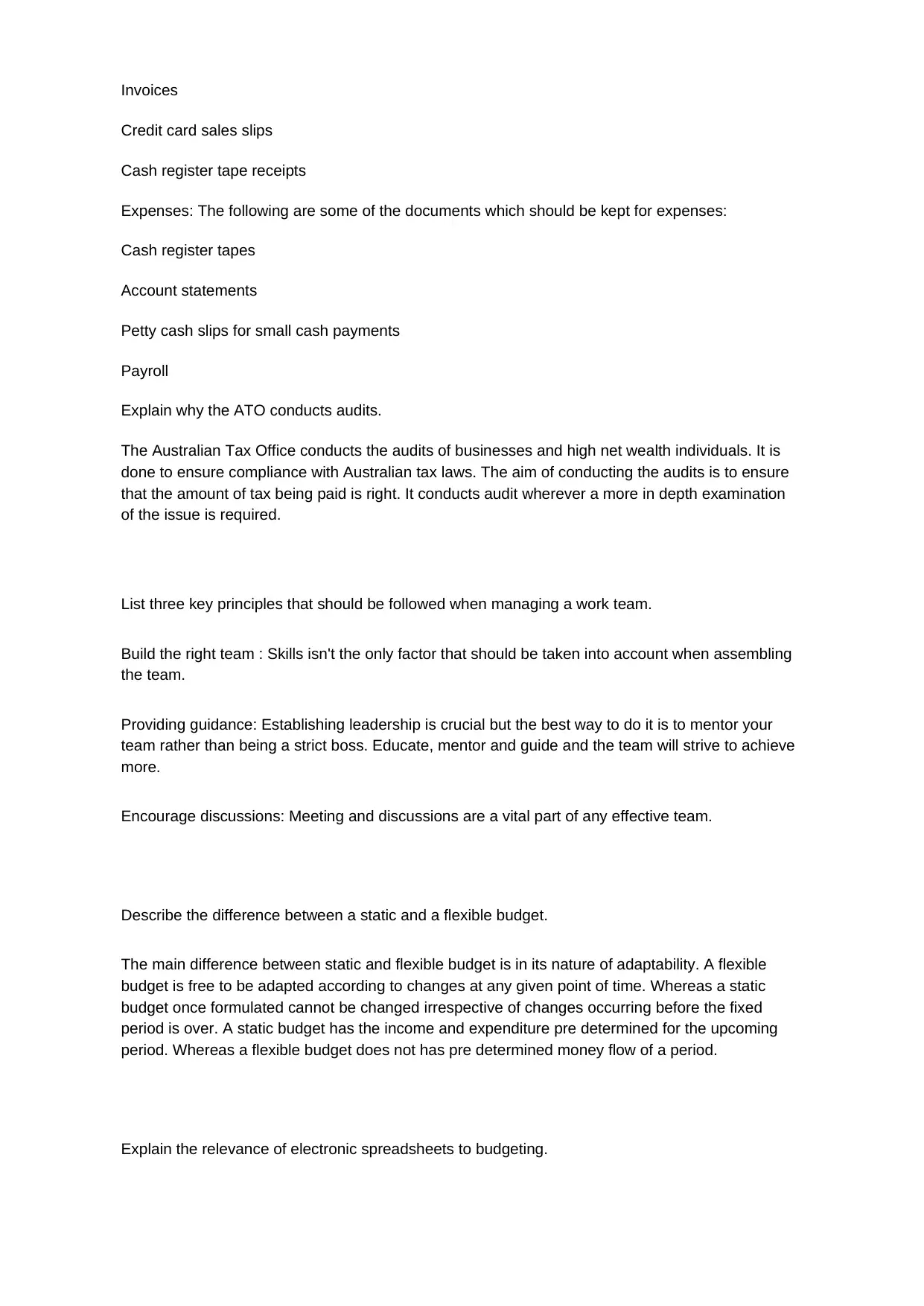
Invoices
Credit card sales slips
Cash register tape receipts
Expenses: The following are some of the documents which should be kept for expenses:
Cash register tapes
Account statements
Petty cash slips for small cash payments
Payroll
Explain why the ATO conducts audits.
The Australian Tax Office conducts the audits of businesses and high net wealth individuals. It is
done to ensure compliance with Australian tax laws. The aim of conducting the audits is to ensure
that the amount of tax being paid is right. It conducts audit wherever a more in depth examination
of the issue is required.
List three key principles that should be followed when managing a work team.
Build the right team : Skills isn't the only factor that should be taken into account when assembling
the team.
Providing guidance: Establishing leadership is crucial but the best way to do it is to mentor your
team rather than being a strict boss. Educate, mentor and guide and the team will strive to achieve
more.
Encourage discussions: Meeting and discussions are a vital part of any effective team.
Describe the difference between a static and a flexible budget.
The main difference between static and flexible budget is in its nature of adaptability. A flexible
budget is free to be adapted according to changes at any given point of time. Whereas a static
budget once formulated cannot be changed irrespective of changes occurring before the fixed
period is over. A static budget has the income and expenditure pre determined for the upcoming
period. Whereas a flexible budget does not has pre determined money flow of a period.
Explain the relevance of electronic spreadsheets to budgeting.
Credit card sales slips
Cash register tape receipts
Expenses: The following are some of the documents which should be kept for expenses:
Cash register tapes
Account statements
Petty cash slips for small cash payments
Payroll
Explain why the ATO conducts audits.
The Australian Tax Office conducts the audits of businesses and high net wealth individuals. It is
done to ensure compliance with Australian tax laws. The aim of conducting the audits is to ensure
that the amount of tax being paid is right. It conducts audit wherever a more in depth examination
of the issue is required.
List three key principles that should be followed when managing a work team.
Build the right team : Skills isn't the only factor that should be taken into account when assembling
the team.
Providing guidance: Establishing leadership is crucial but the best way to do it is to mentor your
team rather than being a strict boss. Educate, mentor and guide and the team will strive to achieve
more.
Encourage discussions: Meeting and discussions are a vital part of any effective team.
Describe the difference between a static and a flexible budget.
The main difference between static and flexible budget is in its nature of adaptability. A flexible
budget is free to be adapted according to changes at any given point of time. Whereas a static
budget once formulated cannot be changed irrespective of changes occurring before the fixed
period is over. A static budget has the income and expenditure pre determined for the upcoming
period. Whereas a flexible budget does not has pre determined money flow of a period.
Explain the relevance of electronic spreadsheets to budgeting.
Paraphrase This Document
Need a fresh take? Get an instant paraphrase of this document with our AI Paraphraser
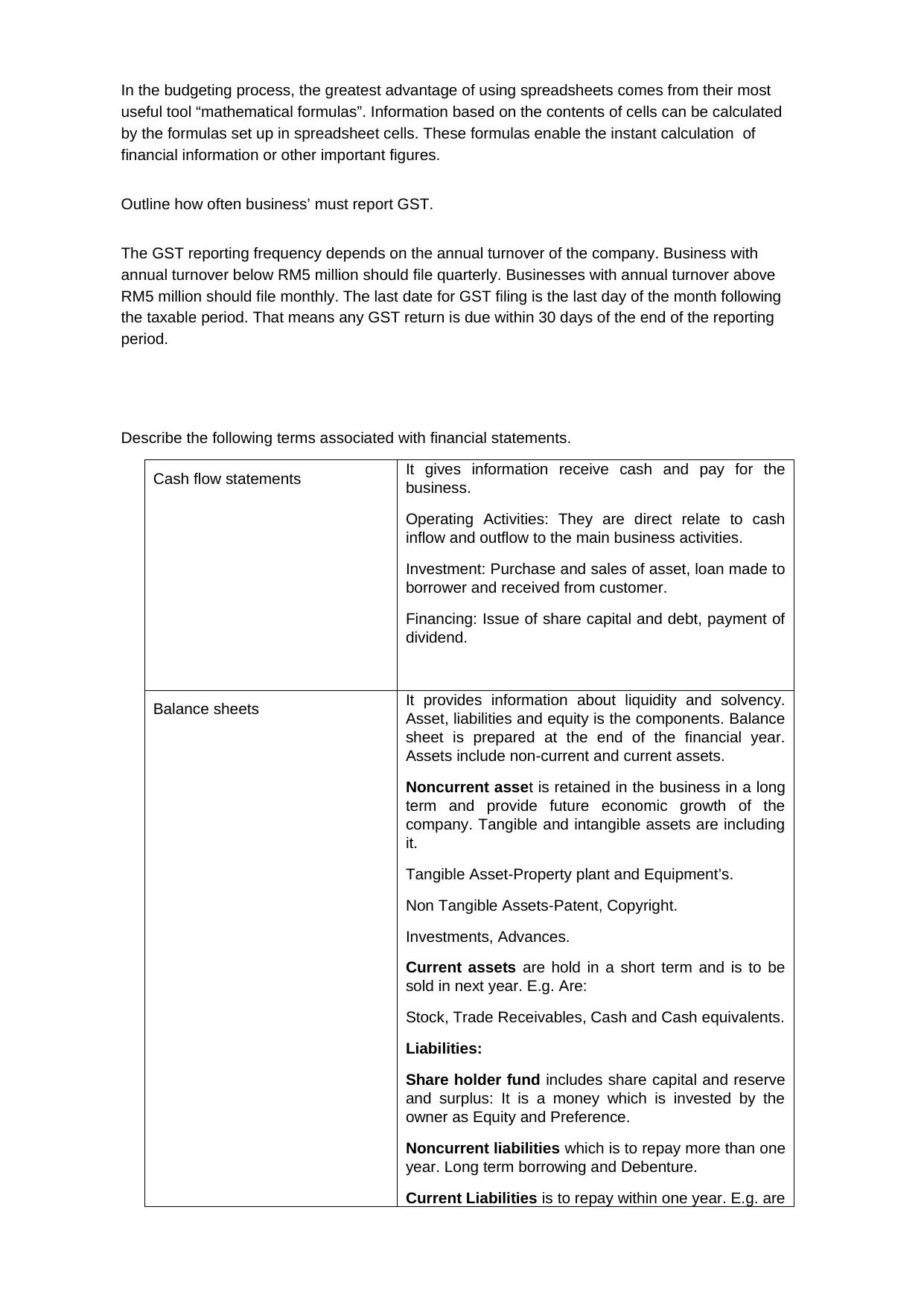
In the budgeting process, the greatest advantage of using spreadsheets comes from their most
useful tool “mathematical formulas”. Information based on the contents of cells can be calculated
by the formulas set up in spreadsheet cells. These formulas enable the instant calculation of
financial information or other important figures.
Outline how often business’ must report GST.
The GST reporting frequency depends on the annual turnover of the company. Business with
annual turnover below RM5 million should file quarterly. Businesses with annual turnover above
RM5 million should file monthly. The last date for GST filing is the last day of the month following
the taxable period. That means any GST return is due within 30 days of the end of the reporting
period.
Describe the following terms associated with financial statements.
Cash flow statements It gives information receive cash and pay for the
business.
Operating Activities: They are direct relate to cash
inflow and outflow to the main business activities.
Investment: Purchase and sales of asset, loan made to
borrower and received from customer.
Financing: Issue of share capital and debt, payment of
dividend.
Balance sheets It provides information about liquidity and solvency.
Asset, liabilities and equity is the components. Balance
sheet is prepared at the end of the financial year.
Assets include non-current and current assets.
Noncurrent asset is retained in the business in a long
term and provide future economic growth of the
company. Tangible and intangible assets are including
it.
Tangible Asset-Property plant and Equipment’s.
Non Tangible Assets-Patent, Copyright.
Investments, Advances.
Current assets are hold in a short term and is to be
sold in next year. E.g. Are:
Stock, Trade Receivables, Cash and Cash equivalents.
Liabilities:
Share holder fund includes share capital and reserve
and surplus: It is a money which is invested by the
owner as Equity and Preference.
Noncurrent liabilities which is to repay more than one
year. Long term borrowing and Debenture.
Current Liabilities is to repay within one year. E.g. are
useful tool “mathematical formulas”. Information based on the contents of cells can be calculated
by the formulas set up in spreadsheet cells. These formulas enable the instant calculation of
financial information or other important figures.
Outline how often business’ must report GST.
The GST reporting frequency depends on the annual turnover of the company. Business with
annual turnover below RM5 million should file quarterly. Businesses with annual turnover above
RM5 million should file monthly. The last date for GST filing is the last day of the month following
the taxable period. That means any GST return is due within 30 days of the end of the reporting
period.
Describe the following terms associated with financial statements.
Cash flow statements It gives information receive cash and pay for the
business.
Operating Activities: They are direct relate to cash
inflow and outflow to the main business activities.
Investment: Purchase and sales of asset, loan made to
borrower and received from customer.
Financing: Issue of share capital and debt, payment of
dividend.
Balance sheets It provides information about liquidity and solvency.
Asset, liabilities and equity is the components. Balance
sheet is prepared at the end of the financial year.
Assets include non-current and current assets.
Noncurrent asset is retained in the business in a long
term and provide future economic growth of the
company. Tangible and intangible assets are including
it.
Tangible Asset-Property plant and Equipment’s.
Non Tangible Assets-Patent, Copyright.
Investments, Advances.
Current assets are hold in a short term and is to be
sold in next year. E.g. Are:
Stock, Trade Receivables, Cash and Cash equivalents.
Liabilities:
Share holder fund includes share capital and reserve
and surplus: It is a money which is invested by the
owner as Equity and Preference.
Noncurrent liabilities which is to repay more than one
year. Long term borrowing and Debenture.
Current Liabilities is to repay within one year. E.g. are
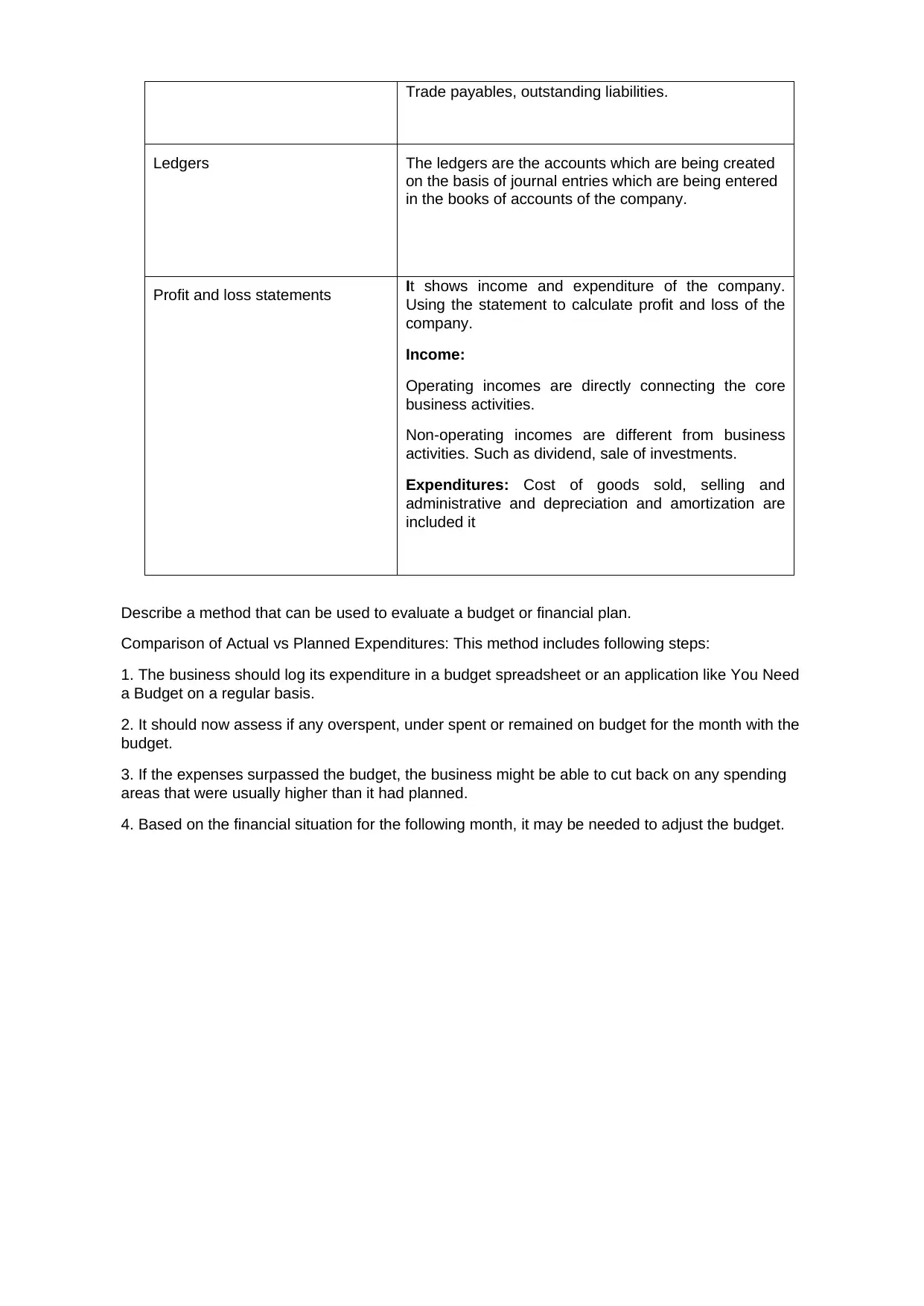
Trade payables, outstanding liabilities.
Ledgers The ledgers are the accounts which are being created
on the basis of journal entries which are being entered
in the books of accounts of the company.
Profit and loss statements It shows income and expenditure of the company.
Using the statement to calculate profit and loss of the
company.
Income:
Operating incomes are directly connecting the core
business activities.
Non-operating incomes are different from business
activities. Such as dividend, sale of investments.
Expenditures: Cost of goods sold, selling and
administrative and depreciation and amortization are
included it
Describe a method that can be used to evaluate a budget or financial plan.
Comparison of Actual vs Planned Expenditures: This method includes following steps:
1. The business should log its expenditure in a budget spreadsheet or an application like You Need
a Budget on a regular basis.
2. It should now assess if any overspent, under spent or remained on budget for the month with the
budget.
3. If the expenses surpassed the budget, the business might be able to cut back on any spending
areas that were usually higher than it had planned.
4. Based on the financial situation for the following month, it may be needed to adjust the budget.
Ledgers The ledgers are the accounts which are being created
on the basis of journal entries which are being entered
in the books of accounts of the company.
Profit and loss statements It shows income and expenditure of the company.
Using the statement to calculate profit and loss of the
company.
Income:
Operating incomes are directly connecting the core
business activities.
Non-operating incomes are different from business
activities. Such as dividend, sale of investments.
Expenditures: Cost of goods sold, selling and
administrative and depreciation and amortization are
included it
Describe a method that can be used to evaluate a budget or financial plan.
Comparison of Actual vs Planned Expenditures: This method includes following steps:
1. The business should log its expenditure in a budget spreadsheet or an application like You Need
a Budget on a regular basis.
2. It should now assess if any overspent, under spent or remained on budget for the month with the
budget.
3. If the expenses surpassed the budget, the business might be able to cut back on any spending
areas that were usually higher than it had planned.
4. Based on the financial situation for the following month, it may be needed to adjust the budget.
⊘ This is a preview!⊘
Do you want full access?
Subscribe today to unlock all pages.

Trusted by 1+ million students worldwide

Assessment Task 1: Checklist
Student’s name:
Did the student provide a
sufficient and clear answer
that addresses the suggested
answer for the following?
Completed
successfully? Comments
Yes No
Question 1
Question 2
Question 3
Question 4
Question 5
Question 6
Question 7
Question 8
Question 9
Question 10
Question 11
Question 12
Question 13
Question 14
Task outcome: Satisfactory Not
sati
sfac
tory
Assessor signature:
Assessor name:
Date:
Student’s name:
Did the student provide a
sufficient and clear answer
that addresses the suggested
answer for the following?
Completed
successfully? Comments
Yes No
Question 1
Question 2
Question 3
Question 4
Question 5
Question 6
Question 7
Question 8
Question 9
Question 10
Question 11
Question 12
Question 13
Question 14
Task outcome: Satisfactory Not
sati
sfac
tory
Assessor signature:
Assessor name:
Date:
Paraphrase This Document
Need a fresh take? Get an instant paraphrase of this document with our AI Paraphraser
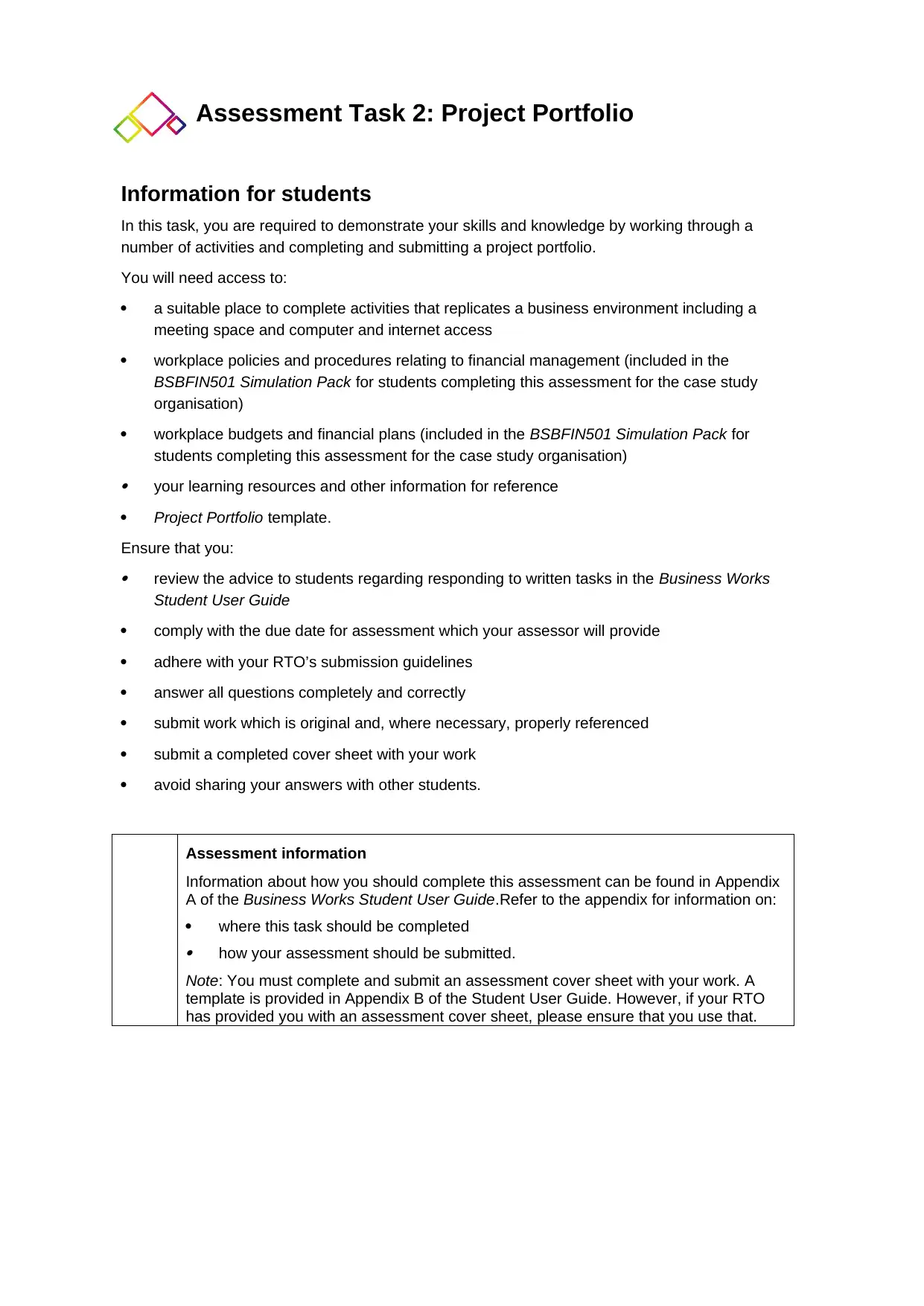
Assessment Task 2: Project Portfolio
Information for students
In this task, you are required to demonstrate your skills and knowledge by working through a
number of activities and completing and submitting a project portfolio.
You will need access to:
a suitable place to complete activities that replicates a business environment including a
meeting space and computer and internet access
workplace policies and procedures relating to financial management (included in the
BSBFIN501 Simulation Pack for students completing this assessment for the case study
organisation)
workplace budgets and financial plans (included in the BSBFIN501 Simulation Pack for
students completing this assessment for the case study organisation) your learning resources and other information for reference
Project Portfolio template.
Ensure that you: review the advice to students regarding responding to written tasks in the Business Works
Student User Guide
comply with the due date for assessment which your assessor will provide
adhere with your RTO’s submission guidelines
answer all questions completely and correctly
submit work which is original and, where necessary, properly referenced
submit a completed cover sheet with your work
avoid sharing your answers with other students.
Assessment information
Information about how you should complete this assessment can be found in Appendix
A of the Business Works Student User Guide.Refer to the appendix for information on:
where this task should be completed
how your assessment should be submitted.
Note: You must complete and submit an assessment cover sheet with your work. A
template is provided in Appendix B of the Student User Guide. However, if your RTO
has provided you with an assessment cover sheet, please ensure that you use that.
Information for students
In this task, you are required to demonstrate your skills and knowledge by working through a
number of activities and completing and submitting a project portfolio.
You will need access to:
a suitable place to complete activities that replicates a business environment including a
meeting space and computer and internet access
workplace policies and procedures relating to financial management (included in the
BSBFIN501 Simulation Pack for students completing this assessment for the case study
organisation)
workplace budgets and financial plans (included in the BSBFIN501 Simulation Pack for
students completing this assessment for the case study organisation) your learning resources and other information for reference
Project Portfolio template.
Ensure that you: review the advice to students regarding responding to written tasks in the Business Works
Student User Guide
comply with the due date for assessment which your assessor will provide
adhere with your RTO’s submission guidelines
answer all questions completely and correctly
submit work which is original and, where necessary, properly referenced
submit a completed cover sheet with your work
avoid sharing your answers with other students.
Assessment information
Information about how you should complete this assessment can be found in Appendix
A of the Business Works Student User Guide.Refer to the appendix for information on:
where this task should be completed
how your assessment should be submitted.
Note: You must complete and submit an assessment cover sheet with your work. A
template is provided in Appendix B of the Student User Guide. However, if your RTO
has provided you with an assessment cover sheet, please ensure that you use that.

Activities
Complete the following activities:
1. Carefully read the following:
This assessment requires you to demonstrate your skills and knowledge in
managing budgets and financial plans.
This project can be based on the case study business in the BSBFIN501 Simulation
Pack or you may like to base this on your own business, or a business you are
currently working for or are familiar with. Speak to your assessor to get approval if
you want to base this on your own business or one you work for.
You will be collecting evidence for this unit in a Project Portfolio. The steps you
need to take are outlined below.
Preparation
Make sure you are familiar with the business you are basing this assessment on
and have read through the necessary background information and policies and
procedures. For the case study business, this is all of the documents included in
the BSBFIN501 Simulation Pack. If it’s your own business or a business where you
are working or are familiar with, it’s important at this step that you have your
business or case study approved by your assessor.
Complete Page 4 of your Project Portfolio for this unit.
Read through the requirements of Section 1, 2, 3 and 4 of your Project Portfolio
which include detailed guidance relevant to all the assessment activities.
Remember to create logical folders for all of your work and in the final assessment
task you will submit a screenshot of these folders. This will ensure you follow record
keeping requirements.
2. Plan financial management approaches.
You are required to plan financial management approaches for a business. This
involves:
Accessing, reviewing and then reporting on the budget and financial plans
relevant to your team or department.
Evaluating budget and financial plan outcomes.
Preparing contingency plans in case plans need to be varied.
Identifying if any changes need to be made to the budget and financial plans
and negotiating these changes.
If you are completing this for the case study business, you will answer all the
questions in your Portfolio based on your Simulation Pack. If it is your own
business, you will need to access the budgets and financial plans relevant to your
team or department, as well as relevant workplace policies and procedures.
Complete Section 1 of your Project Portfolio.
Submit your Portfolio to your assessor.
Preparing to implement financial management plans
You are to prepare a presentation to provide to your team. This can be any format
you wish as per the instructions in your Portfolio. The purpose of the presentation is
Complete the following activities:
1. Carefully read the following:
This assessment requires you to demonstrate your skills and knowledge in
managing budgets and financial plans.
This project can be based on the case study business in the BSBFIN501 Simulation
Pack or you may like to base this on your own business, or a business you are
currently working for or are familiar with. Speak to your assessor to get approval if
you want to base this on your own business or one you work for.
You will be collecting evidence for this unit in a Project Portfolio. The steps you
need to take are outlined below.
Preparation
Make sure you are familiar with the business you are basing this assessment on
and have read through the necessary background information and policies and
procedures. For the case study business, this is all of the documents included in
the BSBFIN501 Simulation Pack. If it’s your own business or a business where you
are working or are familiar with, it’s important at this step that you have your
business or case study approved by your assessor.
Complete Page 4 of your Project Portfolio for this unit.
Read through the requirements of Section 1, 2, 3 and 4 of your Project Portfolio
which include detailed guidance relevant to all the assessment activities.
Remember to create logical folders for all of your work and in the final assessment
task you will submit a screenshot of these folders. This will ensure you follow record
keeping requirements.
2. Plan financial management approaches.
You are required to plan financial management approaches for a business. This
involves:
Accessing, reviewing and then reporting on the budget and financial plans
relevant to your team or department.
Evaluating budget and financial plan outcomes.
Preparing contingency plans in case plans need to be varied.
Identifying if any changes need to be made to the budget and financial plans
and negotiating these changes.
If you are completing this for the case study business, you will answer all the
questions in your Portfolio based on your Simulation Pack. If it is your own
business, you will need to access the budgets and financial plans relevant to your
team or department, as well as relevant workplace policies and procedures.
Complete Section 1 of your Project Portfolio.
Submit your Portfolio to your assessor.
Preparing to implement financial management plans
You are to prepare a presentation to provide to your team. This can be any format
you wish as per the instructions in your Portfolio. The purpose of the presentation is
⊘ This is a preview!⊘
Do you want full access?
Subscribe today to unlock all pages.

Trusted by 1+ million students worldwide
1 out of 17
Related Documents
Your All-in-One AI-Powered Toolkit for Academic Success.
+13062052269
info@desklib.com
Available 24*7 on WhatsApp / Email
![[object Object]](/_next/static/media/star-bottom.7253800d.svg)
Unlock your academic potential
Copyright © 2020–2025 A2Z Services. All Rights Reserved. Developed and managed by ZUCOL.





